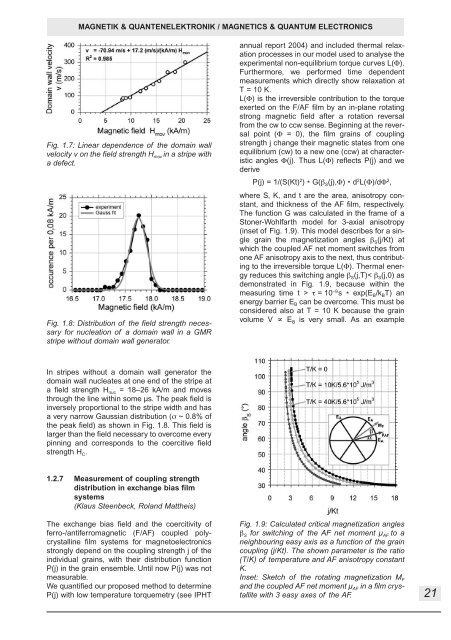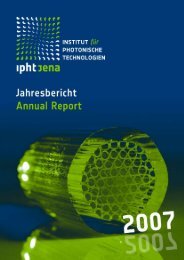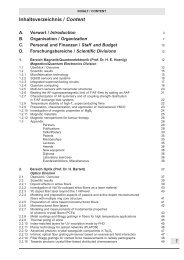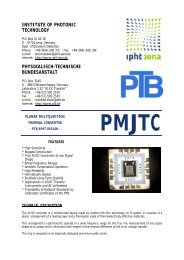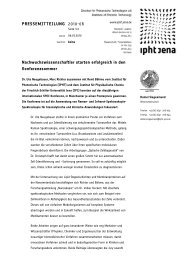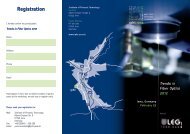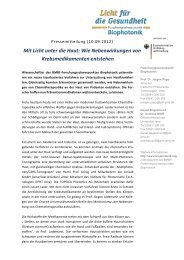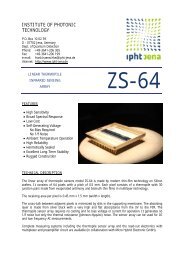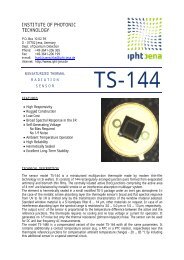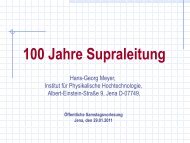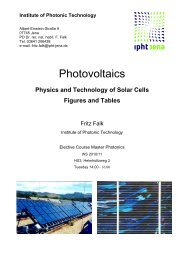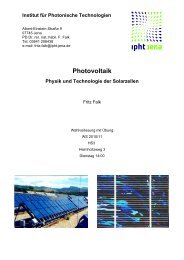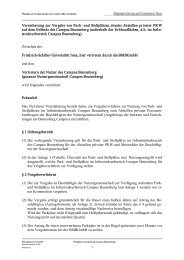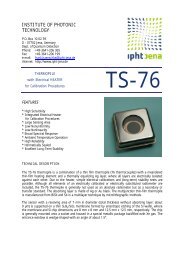Jahresbericht 2005 - IPHT Jena
Jahresbericht 2005 - IPHT Jena
Jahresbericht 2005 - IPHT Jena
You also want an ePaper? Increase the reach of your titles
YUMPU automatically turns print PDFs into web optimized ePapers that Google loves.
MAGNETIK & QUANTENELEKTRONIK / MAGNETICS & QUANTUM ELECTRONICS<br />
Fig. 1.7: Linear dependence of the domain wall<br />
velocity v on the field strength H mov in a stripe with<br />
a defect.<br />
Fig. 1.8: Distribution of the field strength necessary<br />
for nucleation of a domain wall in a GMR<br />
stripe without domain wall generator.<br />
In stripes without a domain wall generator the<br />
domain wall nucleates at one end of the stripe at<br />
a field strength H nuc = 18–26 kA/m and moves<br />
through the line within some µs. The peak field is<br />
inversely proportional to the stripe width and has<br />
a very narrow Gaussian distribution (σ ~ 0.8% of<br />
the peak field) as shown in Fig. 1.8. This field is<br />
larger than the field necessary to overcome every<br />
pinning and corresponds to the coercitive field<br />
strength H C.<br />
1.2.7 Measurement of coupling strength<br />
distribution in exchange bias film<br />
systems<br />
(Klaus Steenbeck, Roland Mattheis)<br />
The exchange bias field and the coercitivity of<br />
ferro-/antiferromagnetic (F/AF) coupled polycrystalline<br />
film systems for magnetoelectronics<br />
strongly depend on the coupling strength j of the<br />
individual grains, with their distribution function<br />
P(j) in the grain ensemble. Until now P(j) was not<br />
measurable.<br />
We quantified our proposed method to determine<br />
P(j) with low temperature torquemetry (see <strong>IPHT</strong><br />
annual report 2004) and included thermal relaxation<br />
processes in our model used to analyse the<br />
experimental non-equilibrium torque curves L(Φ).<br />
Furthermore, we performed time dependent<br />
measurements which directly show relaxation at<br />
T = 10 K.<br />
L(Φ) is the irreversible contribution to the torque<br />
exerted on the F/AF film by an in-plane rotating<br />
strong magnetic field after a rotation reversal<br />
from the cw to ccw sense. Beginning at the reversal<br />
point (Φ = 0), the film grains of coupling<br />
strength j change their magnetic states from one<br />
equilibrium (cw) to a new one (ccw) at characteristic<br />
angles Φ(j). Thus L(Φ) reflects P(j) and we<br />
derive<br />
P(j) = 1/(S(Kt) 2 ) * G(βS(j),Φ) * d2L(Φ)/dΦ2 ,<br />
where S, K, and t are the area, anisotropy constant,<br />
and thickness of the AF film, respectively.<br />
The function G was calculated in the frame of a<br />
Stoner-Wohlfarth model for 3-axial anisotropy<br />
(inset of Fig. 1.9). This model describes for a single<br />
grain the magnetization angles βS(j/Kt) at<br />
which the coupled AF net moment switches from<br />
one AF anisotropy axis to the next, thus contributing<br />
to the irreversible torque L(Φ). Thermal energy<br />
reduces this switching angle βS(j,T)< βS(j,0) as<br />
demonstrated in Fig. 1.9, because within the<br />
measuring time t > τ =10 –9s * exp(EB/kBT) an<br />
energy barrier EB can be overcome. This must be<br />
considered also at T = 10 K because the grain<br />
volume V � EB is very small. As an example<br />
Fig. 1.9: Calculated critical magnetization angles<br />
β S for switching of the AF net moment µ AF to a<br />
neighbouring easy axis as a function of the grain<br />
coupling (j/Kt). The shown parameter is the ratio<br />
(T/K) of temperature and AF anisotropy constant<br />
K.<br />
Inset: Sketch of the rotating magnetization M F<br />
and the coupled AF net moment µ AF in a film crystallite<br />
with 3 easy axes of the AF.<br />
21


